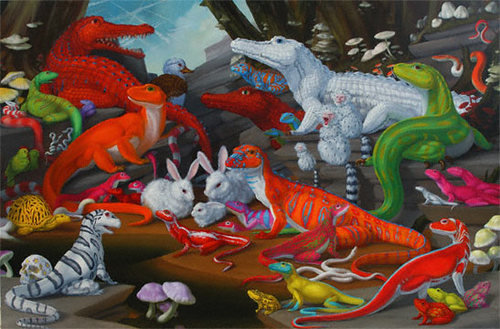Laurie Hogan
dal 3/11/2006 al 21/12/2006
Segnalato da
3/11/2006
Laurie Hogan
Koplin Del Rio Gallery, Los Angeles
The Course of Empire. The show’s title refers to Thomas Cole’s allegorical paintings depicting the progress of a society from a savage state to eventual dissolution and extinction. Through her paintings, sculptures and costumes, Hogan exposes how the exploitation of resources and the cultural complacency of our own socio-political systems heighten the process of distortion and destruction.

The Course of Empire
by Elenore Welles
Anyone with a concern for our ecology and environment will view Laurie
Hogan’s knife-edged allegories of paradise imperiled as cautionary tales.
The show’s title, “The Course of Empire," refers to Thomas Cole’s
allegorical paintings depicting the progress of a society from a savage
state to eventual dissolution and extinction. Through her paintings,
sculptures and costumes, Hogin exposes how the exploitation of resources
and the cultural complacency of our own socio-political systems heighten
the process of distortion and destruction.
Studies from the Environmental Protection Agency show that the cumulative
effect of many chemical substances which acculmulate in the body so as to
change the biochemical viability of cells. In other words, environmental
toxins are not only health risks, they can potentially alter genetics. The
mutant creatures that inhabit Hogin’s paintings thus act as a mordant
warning.
In “A Natural History of Chromophilia II, Northeast and Central Regions,"
day-glo colored reptiles, patterned after industrial commodities are
closely gathered in a fantastic landscape. By contrast, realistic white
bunny rabbits, their fur finely rendered, heighten the intensity of the
unnatural flora and fauna. Save for the inclusion of a skull, their
arrangement and scale evoke a benign collection of toys. A series of
monstrous monkey portraits vividly envision the inherent horrors of toxic
effects. Their vibrant colors range from seductive fuchsias to bright
yellows and greens. They seduce and horrify at the same time.
In Christian iconography, the monkey symbolizes degraded humanity. Here,
ostensibly, it is humans who take on that mantle. The monkeys snarl and
glare, seemingly incensed at the humans who torment them. Made all the
more intense by frenzied human eyes, the animals bang on skulls to evoke
an admonishing memento mori. The day-glo color palette reflects the
language and colors of advertising, fashion, and consumerism.
Ecosystems of industry and commerce foster our desires and mediate our
identities, with marketing mechanisms exploiting fantasies that feed the
mass penchant for consumption. A title telegraphs that Hogin is surely
incensed by seductive advertising aimed directly at her kids: “The
Colonization of My Child’s Mind: The Colors of 12 Hours of Advertising on
Saturday Morning TV."
Another series of vividly colored paintings depict angry little song
birds, also endowed with human eyes. They peer at your with the accusatory
glances of the exploited.
Hogin’s paintings of beasts and birds, although warped, bear a
relationship to symbolisms prevalent in Medieval and Renaissance art. As
subject matter, they had multiple references, often epitomizing attitudes
of society. In Neo-Platonic iconography, for instance, they could
represent combat between reason and sensuality. Also visible is the
influence of 17th century Dutch animal paintings. Alluding to precedents,
Hogin’s art serves as a form of modern vanitas, evoking the futilities of
pleasure and the certainty of death. Sardonic commentaries carry forth in
sculptures such as “Patriot," consisting of large red, white and blue
fungi of cast resin. The sickly mold that seeps through walls is a not too
subtle intimation of inner rot.
Among her costumes is a ceremonial military uniform adorned with gilded
chicken bones that are sewn together with red silk thread. It is a wry
commentary on the warrior as society’s ultimate hero.
Compelling in their revelations, her works are intended to prick the
viewer’s conscience. They ask: How deep is our yen for luxury, knowing it
can result in the alienation and destruction of the natural world? As
implicit caveats, Hogin’s trenchant expressions transport us into a world
where the implausible can and indeed does become devastatingly possible.
Opening: November, 3, 2006
Koplin Del Rio Gallery
464 North Robertson Boulevard, West Hollywood - Los Angeles



